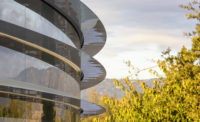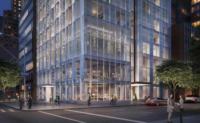Believe it or not, more than a century before we could Aerobicise, Tae Bo, or SoulCycle our way to a svelte physique, Victorian England had its own preoccupation with getting buff. In a 1903 letter to the editor of the Guardian, Arthur G. Mears bemoaned the state of London’s flabby youth, “painfully apparent in the public streets.” Physical strength, he wrote, was the element “upon which the future of the nation depends.”
Mr. Mears was the secretary of the German Gymnastic Society, an athletic association headquartered in a yellow-brick building adjacent to St. Pancras station. The Turnhalle was constructed by German ex-pats in 1865 and—as one of London’s first purpose-built gyms—championed vigorous sporting activities like fencing, boxing, and gymnastics. Damage from a zeppelin raid in 1918, toward the end of the First World War, brought an untimely end to the society, and the building became the property of the Great Northern Railway.
Last fall, the sporting club was reincarnated as a glamorous temple to Mittel-European cuisine—a turn of events that would have been sure to dismay Mr. Mears. Designed by London-based Conran and Partners, founded by the legendary Terence Conran, and rechristened the German Gymnasium, the restaurant is simultaneously a chic new fixture in this rapidly evolving district and a relic of the neighborhood’s past. In developing an approach that would offer a unique dining experience while maintaining the building’s spirit, “our starting point was the history of the building,” says Tina Norden, lead designer and project director.
Thanks to a 2007 master plan, the neighborhood surrounding the German Gymnasium—once notorious for crime and prostitution—has experienced an urban renaissance. In addition to the renovation of St. Pancras Station and its Gothic Revival hotel, and the redevelopment of adjacent King’s Cross station (RECORD, June 2012), the area is now home to parks, restaurants, Central Saint Martins College of Art and Design, and shiny new office towers; Google will soon be moving into an 11-story building by Mossessian Architecture. In 2011, as part of the plan, the developer Argent selected hospitality group D&D London and Conran and Partners to come up with both a design and an overall dining concept for the heritage-listed gymnasium.
When the architects arrived, the building bore little resemblance to its original self. Throughout the 20th century, it had undergone numerous transformations (it had stints as an office and as an artists residence), the most drastic of which was the infill of original viewing galleries to create a second floor, slicing the vast hall in two. There were also pressing structural concerns: turn-of-the-last-century laminated timber roof trusses (secured with bolts and still embedded with hooks used to support gymnasts’ ropes) were causing the masonry walls to buckle.
The base-building architect Allies and Morrison, working closely with Conran and Partners, removed the second floor slab and reintroduced the galleries where Victorian spectators would have once watched boxing matches. They also inserted stainless-steel tension rods to support the splaying walls, retiled the aging roof, and added a pair of blackened-steel staircases leading to the upper level galleries.
For the interiors, project director Norden and her team channeled the building’s history. But the architect (herself German) reluctantly admits, “If you open a German restaurant, people immediately think of oompah music and steins.” So, instead, they drew inspiration from the grand coffeehouses and brasseries of central Europe in that period—to dazzling effect. The lower level is bordered by the muscular twin staircases and anchored by a marble-topped bar on the southwest side. In addition to providing the room’s glowing focal point, the bar is also the gateway to the kitchen; diners can view the chefs at work from across the room. At the center of the dining floor is a cross-shaped banquette made from walnut, brass, and marble, surrounded by café-style tables. Soft eye-level lighting, blush-pink upholstery, and walnut detailing lend warmth to the dramatic open space.
The design team also created numerous subtle references to the gymnasium’s athletic past: the grand staircases’ wood handrails evoke parallel bars, and bronze mesh screens hint at fencing masks. When viewed from above, the ground level’s granite and marble floors take on the lines of a playing court.
Upstairs, the viewing gallery becomes more intimate, with dining spaces tucked into cozy niches. The restaurant can accommodate more than 400 diners, but you wouldn’t know it, given how the architects strategically divided the space by nestling banquettes into the bays behind by the original Corinthian columns and creating snug clusters of seating in open areas.
The team inserted a mezzanine between the ground and second floors to conceal a pastry kitchen, offices, and a boiler room, and stowed mechanicals and a second-floor kitchen behind a mirrored bronze volume above and beyond the bar, which vividly reflects the geometries of the dining room and enables the soaring timber roof to steal the show.
The German Gymnasium, by virtue of its bustling location, is attracting a diverse clientele, from commuters to office workers to university students. On a recent morning, a traveler sipped coffee while engrossed in the day’s newspaper while, across the room on a banquette, a group of colleagues huddled around a laptop. The menu reflects the area’s newfound tastes with offerings ranging from truffled beef broth to grilled tiger prawns, but Bavarian stick-to-your-ribs classics still abound. And like the restaurant’s requisite schnitzel and sauerkraut, the building feels, says Norden, “as if it has always been there.”
PeopleArchitect: Conran and Partners Personnel in architect's firm who should receive special credit: Tina Norden RIBA (UK Registered Architect and Project Director at Conran and Partners) Engineers: Project Manager/QS: PSE Associates Consultants Lighting: Into Lighting General contractor: 3Interiors
|
ProductsInterior Finishes Wall coverings: Muzeo Raised flooring: Fumed Oak Flooring - Havwoods Special interior finishes unique to this project: Fumed Oak Flooring - Havwoods Furnishings Other furniture:All loose furniture supplied by: SCP Contracts |





















Post a comment to this article
Report Abusive Comment